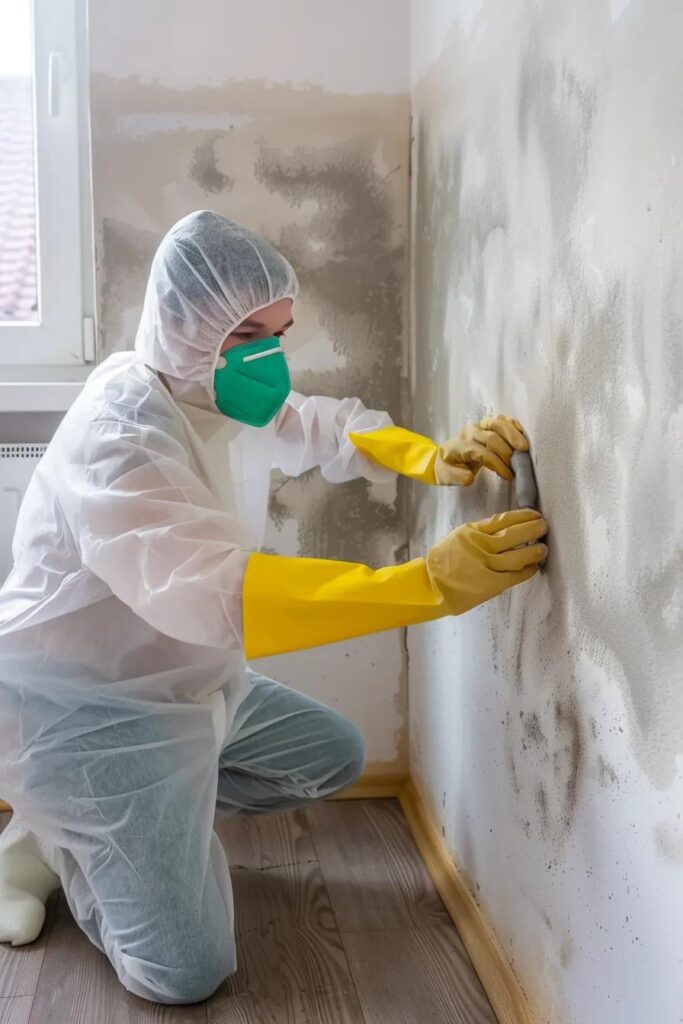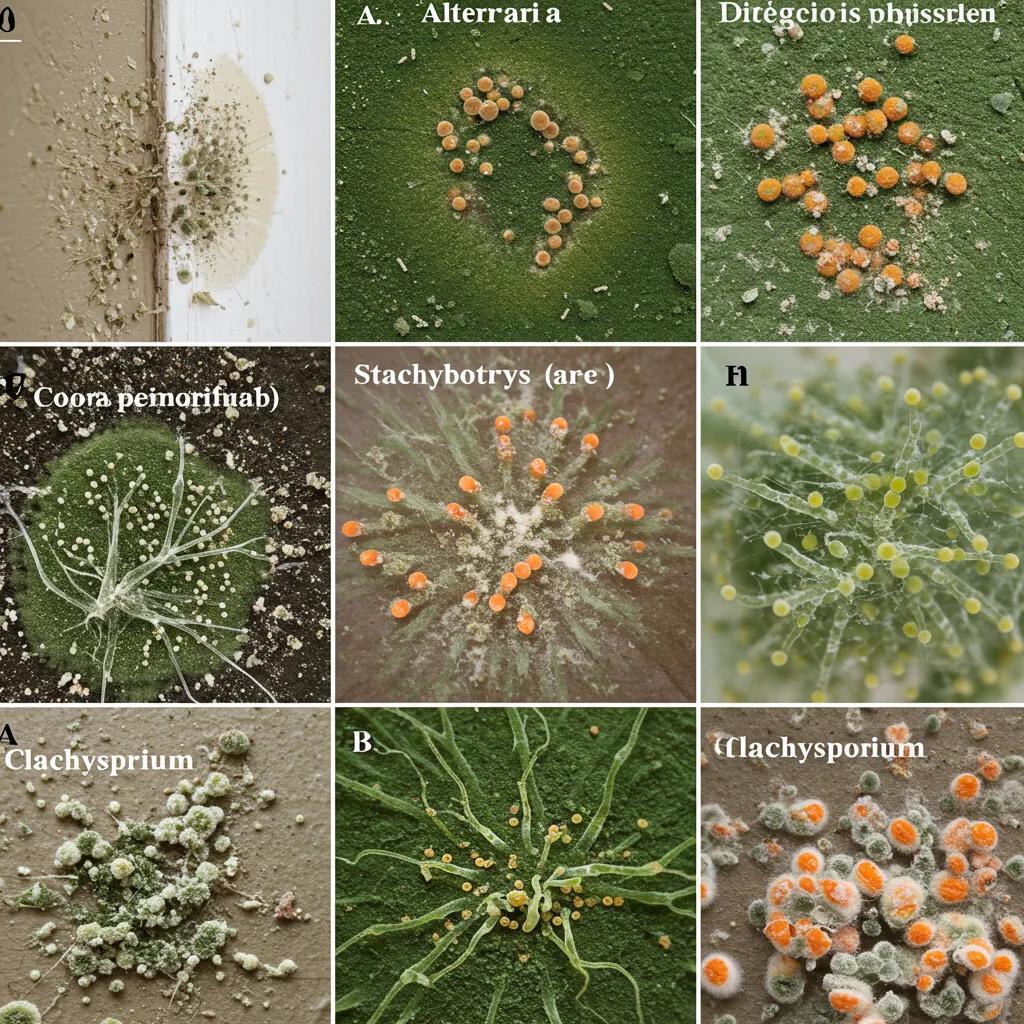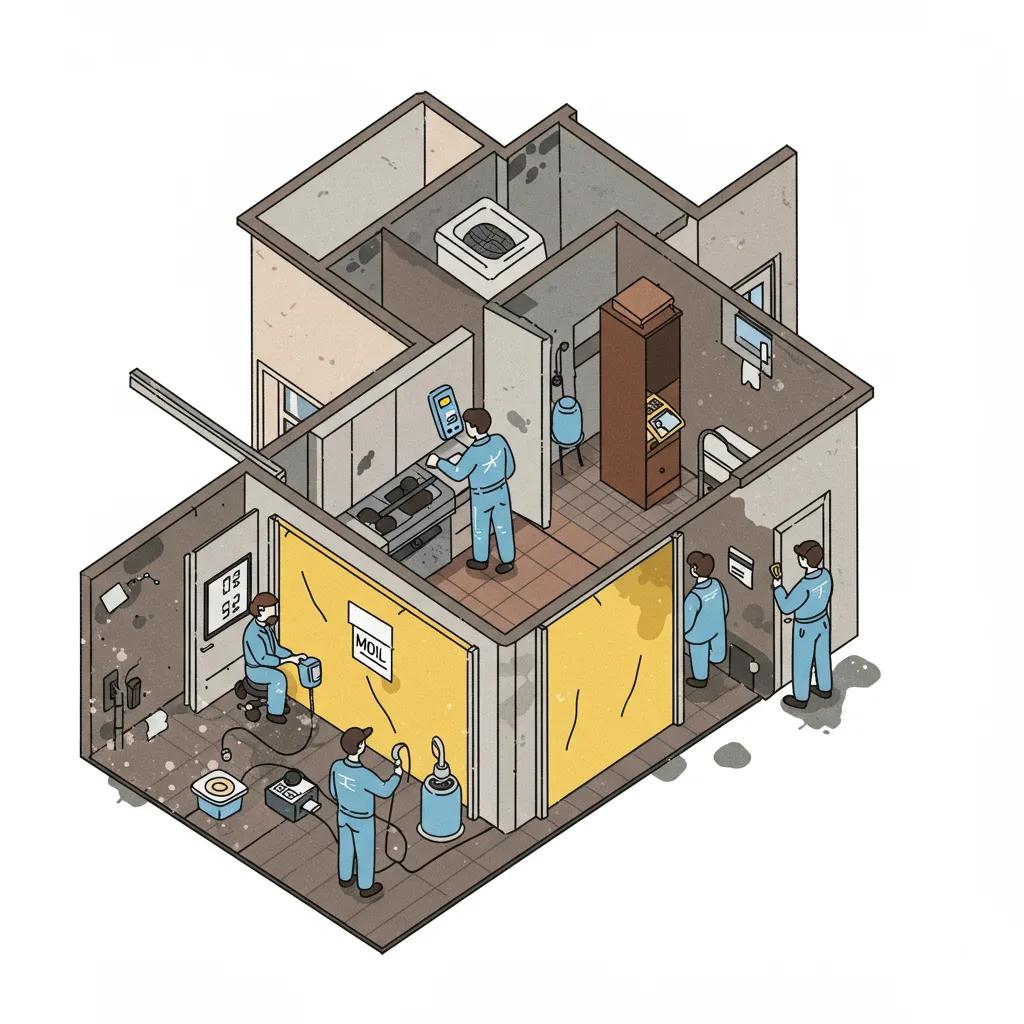
Comprehensive Guide to Apartment Mold Removal and Remediation Services
Removing mold from apartment buildings requires professional care to keep residents safe and protect property value. This guide explains how to spot common mold types, who is responsible for cleanup, and what the professional remediation process looks like. It also covers prevention strategies, testing and inspection services, effective removal methods, cost factors, and the latest detection tools. With clear best practices and expert tips, this resource gives property managers, landlords, and tenants a complete roadmap for safe mold remediation and long-term prevention.
What Are the Most Common Types of Mold Found in Apartment Complexes?

Mold in apartment complexes is a fungal growth that thrives in damp, poorly ventilated areas and can compromise indoor air quality, triggering health issues and structural damage. Recognizing species like Alternaria, Aspergillus, Stachybotrys, and Cladosporium enables tailored remediation methods that remove contamination at its source. For example, black Stachybotrys colonies under bathroom sinks often require containment and HEPA filtration, while allergenic Cladosporium on window frames can be cleaned with antimicrobial coatings. Understanding each mold’s characteristics allows property managers and remediation services to deploy the most effective protocols and minimize recurrence.
Below are the four most common mold types encountered in multi-unit residential buildings, along with their distinctive traits:
- Alternaria: Fuzzy dark green to brown patches that favor cool surfaces like window sills.
- Aspergillus: Powdery yellow or gray growth often found in HVAC ducts and air vents.
- Stachybotrys (Black Mold): Slimy black clusters on cellulose-rich materials after prolonged water damage.
- Cladosporium: Olive green to black spots that colonize wallpapers and carpet edges.
Each mold species poses unique removal challenges, so professional services often begin with species identification and moisture source elimination before executing targeted cleanup. Knowing how to spot these molds sets the stage for precise testing and containment in the next section.
How to Identify Common Household Molds
Mold types can often be recognized by their appearance and where they grow:
Alternaria – Olive-brown, velvety patches, often found in places with occasional condensation (CDC on common molds).
Aspergillus – Powdery spores that range from pale yellow to brown, commonly seen on warm surfaces near HVAC vents (NIH on Aspergillus).
Stachybotrys (black mold) – Thick, black mats on water-damaged drywall or wood, usually with a strong musty smell (EPA guidance on black mold).
Cladosporium – Olive-green clusters that spread along grout lines, carpets, and other damp surfaces (World Health Organization on indoor air quality and mold).
Professionals use tools like moisture meters, air samples, and surface swabs to confirm which species is present. They also check humidity, temperature, and building materials. This detailed inspection helps create a remediation plan that targets both visible mold and hidden spores, ensuring it doesn’t come back after cleanup. For more on professional testing, see the EPA’s mold testing guidelines.
Health Risks of Mold Exposure
Different types of mold can affect people in many ways. Alternaria often causes allergy-like reactions such as sneezing and itchy eyes. Aspergillus can irritate the airways, triggering breathing problems in sensitive individuals. Stachybotrys (commonly called “black mold”) produces toxins that may lead to constant coughing and, in rare cases, weaken the immune system. Cladosporium is known to worsen asthma symptoms and can cause skin rashes when touched. For people with weakened immune systems, these molds are especially dangerous, making fast cleanup and removal essential.
Medical studies also show that long-term mold exposure can make respiratory issues worse and raise the risk of sinus infections. Children and older adults, who have less robust immune defenses, often experience stronger symptoms. Effective mold remediation not only clears away visible growth but also lowers airborne spore counts. This improves indoor air quality and reduces health problems for everyone in the home or workplace.
When to Call a Mold Remediation Specialist
You should call a certified mold remediation specialist if mold covers more than 10 square feet, if you notice musty odors without seeing growth, or if residents experience unexplained breathing issues. Professionals use tools like moisture meters and particle counters to detect hidden colonies behind walls and ceilings.
If your HVAC system is old or suspected of spreading spores through the building, experts can perform advanced air sampling and duct testing. This ensures spores are located and removed at the source.
Early professional intervention is the best way to stop small outbreaks from turning into widespread, costly infestations. By bringing in trained specialists, property owners protect both the health of residents and the long-term integrity of the building. Investing in timely remediation is a smart step in maintaining a safe, healthy environment.
Who Is Responsible for Mold Removal in Rental Apartments?
Responsibility for mold cleanup depends on the cause. Landlords are usually responsible if the mold comes from building problems, such as roof leaks, broken pipes, or poor construction. Tenants may be responsible if mold is caused by not using ventilation, leaving spills unattended, or failing to report water damage quickly.
Leases that clearly explain these responsibilities help avoid confusion. Landlords are legally required to keep apartments safe and livable, which includes fixing mold caused by structural issues. Tenants, on the other hand, must use ventilation systems properly and report leaks or moisture right away.
Good communication between landlords and tenants ensures faster inspections, quicker repairs, and fewer disputes.
What Are Landlord Mold Responsibilities and Legal Obligations?
Landlords must maintain roofing, plumbing, and exterior walls to prevent water intrusion and control indoor humidity. Building codes and habitability laws require prompt repairs of leaks and structural defects that facilitate mold growth. Failure to remedy known hazards within a legally defined timeframe can result in tenant complaints to housing authorities, rent withholding, or litigation. By engaging licensed remediation professionals and following industry standards, landlords uphold their duty of care and minimize liability.
Landlords who contract reputable mold removal services demonstrate compliance with IICRC guidelines and state-level regulations. Documenting inspection reports, repair invoices, and clearance certificates builds a defensible record if disputes arise, safeguarding property owners against potential claims.
What Role Do Tenants Play in Mold Prevention and Reporting?
Tenants should operate exhaust fans in kitchens and bathrooms, keep furniture slightly away from walls to improve air circulation, and use dehumidifiers when indoor humidity exceeds recommended levels (ideally 30–50 percent). Promptly wiping spills, drying wet areas, and reporting drips or condensation issues to the landlord form the frontline defense against mold growth. Regularly checking under sinks and behind appliances for moisture accumulation prevents hidden outbreaks and supports a healthy living environment.
Failure to report leaks or to maintain basic cleanliness can shift remediation costs onto tenants, as mold resulting from neglect often falls outside landlord obligations. Clear tenant responsibilities and proactive behavior reduce both health risks and property damage.
How to Navigate Mold Disputes and Legal Recourse Between Landlords and Tenants?
Dispute resolution begins with written notices detailing mold locations and suspected causes, supported by photographic evidence. If landlords fail to act, tenants can file complaints with local health departments or pursue rent escrow remedies in many jurisdictions. Mediation services or small-claims court offer pathways to resolve cost disputes without extensive legal fees. Both parties benefit from documented inspection and remediation records, ensuring fair outcomes and restoring safe living conditions swiftly.
How Does the Professional Mold Remediation Process Work in Apartment Complexes?

A structured remediation process combines inspection, containment, removal, and verification to eradicate mold safely and prevent relapse. Certified technicians first perform visual assessments, moisture mapping, and air sampling to define the scope of contamination. Following that, they erect containment barriers, deploy negative air machines, and secure unaffected zones. Specialized cleaning agents and HEPA vacuums remove mold colonies, after which antimicrobial treatments protect exposed surfaces. Final clearance testing confirms spore levels meet health-based thresholds before occupants re-enter.
Strict adherence to industry standards ensures every remediation phase addresses both visible and hidden risks, delivering lasting solutions and improved indoor air quality for tenants.
What Is Included in a Mold Inspection and Testing Service?
A comprehensive inspection entails a detailed walkthrough to identify visible growth and moisture sources, moisture meter readings through walls and floors, and environmental sampling of air and surfaces. Laboratory testing of collected swabs and spore traps yields species-specific data, guiding removal strategies. Inspectors document findings in a formal report that outlines affected areas, contamination levels, and recommended actions. This report forms the blueprint for containment design, remediation methods, and post-remediation verification.
Thorough testing verifies moisture mitigation success and informs prevention plans, ensuring remediation addresses both current colonies and potential future hotspots.
Which Mold Removal Techniques Are Most Effective for Apartments?
Effective apartment mold removal techniques include:
- Containment and Negative Air Pressure to isolate contaminated zones and prevent spore migration.
- HEPA Vacuuming to capture fine particulates from surfaces and the air.
- Surface Cleaning with EPA-registered antimicrobial agents that kill mold at the root.
- Controlled Demolition of severely damaged drywall or carpeting when necessary.
- Dry Fog or ULV (Ultra Low Volume) misting to disinfect behind walls and in crawl spaces.
Each method eliminates mold at different stages of the remediation cycle, combining mechanical removal with chemical inactivation. Professionals select techniques based on substrate type, infestation severity, and health-safety considerations.
How Is Post-Remediation Verification Conducted to Prevent Mold Recurrence?
Post-remediation verification involves clearance air sampling and direct surface swabs to ensure spore counts fall below health-based benchmarks. A third-party hygienist or the remediation team will compare post-treatment data to pre-remediation baselines, confirming that interventions succeeded. Moisture levels are re-measured, and areas prone to condensation are monitored over time. A signed clearance certificate provides legal assurance of a safe environment, closing the remediation loop and enabling tenant re-occupancy.
Verification not only validates cleanup efficacy but also reinforces preventive maintenance plans to keep mold at bay.
What Are the Best Mold Prevention Strategies for Apartment Complexes?
Preventing mold hinges on controlling moisture entry, maintaining airflow, and using resilient materials that withstand damp conditions. Proactive strategies include installing dehumidifiers in basements, upgrading ventilation systems with energy recovery ventilators, and repairing plumbing issues immediately upon detection. Applying mold-resistant paints and drywall in high-risk areas adds a passive layer of protection. Routine building inspections and resident education programs foster a culture of vigilance, reducing mold incidents and maintenance costs over the property lifecycle.
How Can Humidity Control Solutions Like Dehumidifiers Help Prevent Mold?
Dehumidifiers extract excess moisture from indoor air, lowering relative humidity to levels that inhibit fungal growth. By maintaining humidity between 30 and 50 percent, these devices prevent spore germination on surfaces and structural components. Portable units in basements and laundry rooms complement whole-building HVAC dehumidification, ensuring critical spaces remain dry. Installing smart dehumidifiers with remote monitoring capabilities alerts maintenance teams to performance issues before mold can establish.
What Role Does Proper Ventilation Play in Mold Prevention?
Proper ventilation exchanges stale, humid air for fresh outdoor air, disrupting the stagnation that fosters mold growth. Exhaust fans in kitchens and bathrooms remove moisture-laden air at its source, while balanced supply and return vents in HVAC systems promote consistent airflow. Energy recovery ventilators reclaim heating and cooling energy while exchanging air, optimizing indoor air quality without sacrificing efficiency. Ventilation upgrades in laundry rooms and utility closets further mitigate hidden moisture accumulation behind walls and appliances.
Advanced HVAC filtration systems are crucial for maintaining optimal indoor air quality by capturing airborne spores and other particulates.
HEPA and Charcoal Filters for Apartment Indoor Air QualityThis study confirms that HEPA and charcoal filters reduce gas and particulate matter concentrations in indoor air. The study evaluated the performance of different mechanical ventilation filters in apartment buildings. The results showed that HEPA filters were the most effective at removing particulate matter, while charcoal filters were effective at removing gases. The study also found that the effectiveness of the filters was dependent on the air change rate and the filter maintenance. The study recommends that HEPA and charcoal filters be used in apartment buildings to improve indoor air quality.Indoor pollutant reduction performance of different mechanical ventilation filters in apartment buildings, Unknown Author, 2023
How Should Water Leaks and Damage Be Addressed Promptly?
Immediate detection and repair of leaks in roofs, plumbing fixtures, and HVAC condensate lines prevent water from seeping into drywall and wood framing. Maintenance protocols should include routine inspections of roof membranes, pipe insulation, and condensate drains. When a leak occurs, affected materials must be dried within 24–48 hours using commercial fans and dehumidifiers to avoid mold colonization. Documenting repair actions and drying times demonstrates due diligence in property upkeep.
Which Mold-Resistant Building Materials and Coatings Are Recommended?
Using moisture-resistant drywall (greenboard), mold-inhibiting primers, and specialty paints adds passive protection against fungal growth in high-humidity areas. Cement board and marine-grade plywood in shower surrounds resist spalling and inhibit mold better than traditional gypsum panels. Moisture-tolerant sealants prevent water infiltration at joints and seams, while antimicrobial additives in wallboard and paint slow mold reproduction. Selecting these materials during renovations or new construction reduces long-term maintenance demands and improves tenant comfort.
Investing in mold-resistant products fortifies apartments against persistent moisture challenges and supports healthy indoor environments.
How Much Does Mold Removal Cost in Apartments and What Factors Affect Pricing?
Apartment mold removal costs vary based on infestation size, mold species, accessibility, and building age. Small-scale cleaning of localized Aspergillus or Cladosporium growth might run $10–$25 per square foot, while extensive Stachybotrys remediation requiring demolition, disposal, and reconstruction can exceed $4,000 for a single unit. Additional costs include laboratory testing, containment barriers, HEPA equipment rental, and post-remediation clearance sampling. Geographic location and prevailing labor rates also influence total expenses.
| Apartment Size | Infestation Severity | Approximate Cost Range |
|---|---|---|
| Studio (200–400 sq ft) | Low to Moderate | $1,200–$2,500 |
| One-Bedroom (500–800 sq ft) | Moderate to High | $2,500–$4,500 |
| Two-Bedroom (900–1,200 sq ft) | High | $4,000–$6,500 |
What Are the Average Mold Remediation Costs by Apartment Size and Mold Severity?
Small infestations under 10 sq ft often cost between $500 and $1,500 to remediate and clear. Moderate outbreaks covering 10–30 sq ft in multiple rooms can range from $2,000 to $4,000, including testing and containment. Severe cases that require structural repairs and material replacement can exceed $5,000 per unit. Bulk pricing for entire complexes or multi-unit orders may reduce per-unit expenses through economies of scale and streamlined logistics.
Does Insurance Typically Cover Mold Damage in Rental Units?
Standard property insurance policies may cover mold remediation if it results from a sudden, accidental water event such as a burst pipe or storm damage. However, policies often exclude mold arising from poor maintenance or prolonged leaks. Tenants’ renters insurance sometimes covers personal property damage from mold but rarely pays for building repairs. Reviewing policy language and documenting cause-and-effect relationships are critical to securing coverage. Endorsements or separate mold riders can extend protection for chronic moisture issues in older properties.
How Do Location and Mold Type Influence Mold Removal Expenses?
Regions with high humidity or frequent rain contribute to elevated mold risk and may attract premium service rates due to increased labor demand. Coastal climates prone to salt air and moisture can accelerate wood decay and mold colonization, raising remediation complexity. Black mold (Stachybotrys) removal often commands higher fees because of specialized containment, toxicity testing, and disposal regulations. Conversely, isolated allergenic mold outbreaks typically involve straightforward cleaning and lower costs. Matching remediation protocols to geographic and biological variables ensures cost-effective, compliant outcomes.
What Are the Health Effects of Mold Exposure in Apartment Residents?
Mold exposure in enclosed living spaces can trigger a spectrum of health problems, from mild allergic reactions to serious respiratory complications. Inhaling spores from Alternaria or Cladosporium often leads to sneezing, itchy eyes, and chronic sinusitis, while prolonged contact with Aspergillus may cause bronchitis-like symptoms. Toxic black mold produces mycotoxins linked to neurological irritation and immune suppression under heavy exposure. Vulnerable populations, including children, older adults, and individuals with compromised immunity, face heightened risks of infections and exacerbated chronic conditions.
Effective remediation not only restores property integrity but also safeguards occupant health by reducing indoor spore loads and improving air quality.
Which Common Health Problems Are Caused by Apartment Mold?
Residents frequently report nasal congestion, throat irritation, and persistent cough when living in mold-infested units. Asthma sufferers may experience increased attack frequency and severity due to airborne allergenic spores. Skin contact with mold-laden surfaces can result in rashes or dermatitis. Long-term exposure to high spore concentrations has been associated with chronic fatigue and headaches, underscoring the need for timely intervention and air quality restoration.
How Does Toxic Mold Differ from Allergenic Mold in Health Impact?
Toxic molds like Stachybotrys chartarum produce secondary metabolites known as mycotoxins that can impair neurological function and weaken immune defenses. Allergenic molds such as Cladosporium primarily provoke allergic reactions without releasing potent toxins. While allergenic species trigger immediate symptoms in sensitive individuals, toxic molds pose broader health threats under severe, sustained exposure. Identifying toxic growth requires laboratory analysis, guiding remediation teams to adopt stricter containment and disposal protocols.
How Can Vulnerable Residents Be Protected from Mold-Related Health Risks?
Protecting at-risk occupants involves relocating children, older adults, and immunocompromised individuals during remediation and clearance testing. Installing HEPA air purifiers and maintaining relative humidity below 50 percent reduce spore exposure. Clear communication of remediation schedules and temporary accommodation options ensures resident safety and compliance with health guidelines. Regular indoor air quality monitoring provides early warning of mold resurgence, safeguarding vulnerable groups over time.
How Can Advanced Technologies Improve Mold Detection and Prevention in Apartments?
Emerging technologies like smart humidity sensors, AI-powered image recognition, and advanced HVAC filtration enhance early mold detection and long-term prevention. Real-time monitoring devices alert maintenance teams to moisture spikes before visible growth occurs. AI models analyze smartphone photos or thermal scans to pinpoint hidden mold hotspots within wall cavities. High-efficiency HVAC filters and UV-C irradiation systems in air handling units deactivate airborne spores, supporting continuous indoor air quality management.
What Are Smart Humidity Monitoring and AI-Powered Mold Detection Tools?
Smart humidity monitors wirelessly transmit relative humidity and temperature data to cloud dashboards, triggering alerts when conditions favor mold. AI-driven smartphone apps analyze surface images for discoloration patterns matching mold species, guiding targeted inspections. Combined, these tools detect moisture anomalies and early growth signs, enabling maintenance teams to address issues before they escalate. Automated reporting features streamline documentation for compliance and insurance purposes.
How Do Advanced HVAC Filtration Systems Help Maintain Indoor Air Quality?
High-efficiency particulate air (HEPA) and MERV-rated filters in HVAC systems capture spores down to 0.3 microns, reducing airborne fungal loads significantly. UV-C lamps installed in ductwork disrupt mold DNA, preventing spore reproduction. Integrated air quality sensors measure particulate counts and volatile organic compounds, adjusting airflow and filtration dynamically. These technologies work in concert to create a continuously sanitized air distribution network, protecting tenants from hidden spore circulation.
What Eco-Friendly and Non-Toxic Mold Remediation Options Are Available?
Green remediation methods use botanical disinfectants, enzyme-based cleaners, and biodegradable antimicrobial solutions that inhibit mold without harsh chemicals. Dry fogging with hydrogen peroxide produces a fine mist that penetrates crevices and breaks down mold cell walls naturally. Encapsulating coatings fortified with silica-based nanoparticles form moisture-resistant barriers on treated surfaces. Eco-certified remediation firms deploy these options to satisfy environmentally conscious clients while delivering safe, effective mold control.
By adopting sustainable remediation protocols, property owners demonstrate environmental stewardship and minimize occupant exposure to volatile chemicals.
Apartment mold removal and remediation services combine precise identification, legal clarity, expert mitigation, and cutting-edge prevention to safeguard multi-unit residences. Establishing clear landlord-tenant protocols, investing in professional inspection and cleanup, and embracing proactive moisture control create healthier, more durable properties. Advanced technologies and eco-friendly materials further fortify indoor environments against fungal threats. Following this comprehensive framework ensures that mold issues are resolved promptly and prevented effectively, preserving both resident well-being and property value.

